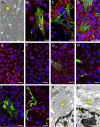Intracellular collagen degradation mediated by uPARAP/Endo180 is a major pathway of extracellular matrix turnover during malignancy
- PMID: 15967816
- PMCID: PMC2171632
- DOI: 10.1083/jcb.200411153
Intracellular collagen degradation mediated by uPARAP/Endo180 is a major pathway of extracellular matrix turnover during malignancy
Abstract
We recently reported that uPARAP/Endo180 can mediate the cellular uptake and lysosomal degradation of collagen by cultured fibroblasts. Here, we show that uPARAP/Endo180 has a key role in the degradation of collagen during mammary carcinoma progression. In the normal murine mammary gland, uPARAP/Endo180 is widely expressed in periductal fibroblast-like mesenchymal cells that line mammary epithelial cells. This pattern of uPARAP/Endo180 expression is preserved during polyomavirus middle T-induced mammary carcinogenesis, with strong uPARAP/Endo180 expression by mesenchymal cells embedded within the collagenous stroma surrounding nests of uPARAP/Endo180-negative tumor cells. Genetic ablation of uPARAP/Endo180 impaired collagen turnover that is critical to tumor expansion, as evidenced by the abrogation of cellular collagen uptake, tumor fibrosis, and blunted tumor growth. These studies identify uPARAP/Endo180 as a key mediator of collagen turnover in a pathophysiological context.
Figures




References
-
- Behrendt, N. 2004. The urokinase receptor (uPAR) and the uPAR-associated protein (uPARAP/Endo180): membrane proteins engaged in matrix turnover during tissue remodeling. Biol. Chem. 385:103–136. - PubMed
-
- Bernstein, E.F., Y.Q. Chen, J.B. Kopp, L. Fisher, D.B. Brown, P.J. Hahn, F.A. Robey, J. Lakkakorpi, and J. Uitto. 1996. Long-term sun exposure alters the collagen of the papillary dermis. Comparison of sun-protected and photoaged skin by northern analysis, immunohistochemical staining, and confocal laser scanning microscopy. J. Am. Acad. Dermatol. 34:209–218. - PubMed
-
- Bugge, T.H., L.R. Lund, K.K. Kombrinck, B.S. Nielsen, K. Holmback, A.F. Drew, M.J. Flick, D.P. Witte, K. Danø, and J.L. Degen. 1998. Reduced metastasis of Polyoma virus middle T antigen-induced mammary cancer in plasminogen-deficient mice. Oncogene. 16:3097–3104. - PubMed
-
- Chambers, A.F., A.C. Groom, and I.C. MacDonald. 2002. Dissemination and growth of cancer cells in metastatic sites. Nat. Rev. Cancer. 2:563–572. - PubMed
Publication types
MeSH terms
Substances
Associated data
- Actions
- Actions
- Actions
LinkOut - more resources
Full Text Sources
Other Literature Sources
Molecular Biology Databases

